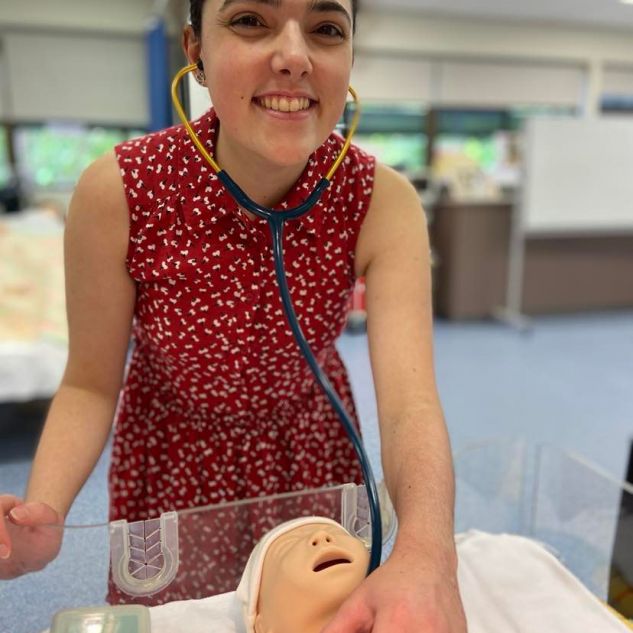Written By
Nicolette Ward
College/Division
College of Healthcare Sciences
Publish Date
5 May 2022
Related Study Areas
Professionalism and partnership during placements
Having already assisted in the birth of numerous babies throughout her studies while on various placements, JCU Student Samantha Galea says she feels more than ready to be a midwife after she graduates from her double degree in nursing and midwifery at the end of the year.
I’ve just come back from an eight-week placement at Proserpine Hospital where I got to help birth ten babies. Being in a smaller rurally based hospital gives you a lot of exposure and experience as you get to see everything, you're part of everything, and you get a chance to do everything. The doctors, nurses and midwives there are a very tight-knit team and are just so supportive in helping and guiding you in your education and in your professionalism.
My very first childbirth experience was at the start of my second year as part of the JCU midwifery continuity of care student experiences, in which we partner with pregnant women throughout their pregnancy and birth journey. You accompany them to their antenatal appointments, are at their birth with the midwife, and then follow them for up to six weeks after they have had their baby. We do a minimum of ten of these experiences throughout our degree and get to form some really strong bonds with the pregnant ladies.
In addition to these practical hands-on experiences, Samantha also spent some time in Atherton on the Midwifery Group Practice program which enables midwives to provide the all-important continuity of care to pregnant women.
For this placement I had the opportunity to provide that continuity of care before, during and after birth, working alongside a supervising midwife. It really showed me that this is the role I want to be a part of because it most closely reflects a true model of woman-centred care.
I absolutely love helping bring life into the world; from educating and guiding a woman through her pregnancy journey, to supporting them and to be part of that incredibly special moment in their lives when their baby is born.


The superpowers of a double degree
Although doing a four-year double degree in nursing and midwifery can have its challenges, Samantha says the course is structured in a way that nursing and midwifery are studied alongside each other throughout the course.
There is a focus on common skills in first year, with the first midwifery subject studied in second semester with a two-week midwifery placement alongside a two-week nursing placement. And then when you hit second year, nursing and midwifery becomes quite evenly distributed with two-week double placements for both nursing and midwifery at the end of each semester. For the third and fourth year, nursing and midwifery placements occur in each semester which really helps to consolidate your learning in both fields.
Second year was definitely a turning point for me, because that's when we get to experience being a part of the of the birth process and can put into practice some of the skills and knowledge that you've learned. We are quite a small group of about 20 midwifery students, and so we all get to know each other really well and are there to support each other throughout the degree.
Doing a double degree is absolutely ‘doable’ but you need to be well-organised. It’s also important to remember that sacrificing time to study means you are enabling yourself to accomplish the greatest achievement and satisfaction within your professional life, which will then also influence your personal life when you graduate.


A roller coaster of emotions
Anyone who has been witness to a woman birthing knows that extreme emotions feature strongly throughout the process. So how does a student of midwifery cope with this?
I’ve witnessed births that can take anything from 45 minutes to 25 hours, and sometimes you just have to go with the roller coaster of emotions. I remember the first birth that I was part of I was just bumbling in the corner, crying my eyes out because I was just so overcome with the miracle of birth. Unfortunately, there are also times when you have something unexpected happen, such as when a stillbirth occurs. Crying can be a natural response because it says I am grieving with you.
Even when everything is going fine and looking like the birth is going to be textbook perfect, something unexpected can happen and you always need to be aware and knowledgeable of that. So, you need to be resilient and be able to persevere through some very difficult times.
But the most important ingredient I think to being a midwife is having compassion, to just be present and to listen. As you know some mums can suffer from the postnatal blues or even depression, and as a midwife we need to be understanding and alert to the early signs of this in our follow-up visits.
Of course, the most rewarding part of being a midwife is being there for the miracle of birth itself which makes all the effort so worth it. The smiles on the parents’ faces means more than any words could say.
When I went back to Proserpine Hospital for my second rotation there, I had at least three ladies come back to the hospital to show off their babies that I had helped to birth and ask me if I could be their midwife for their next baby. That level of trust you get is just phenomenal and is what makes the midwifery profession so special to me.